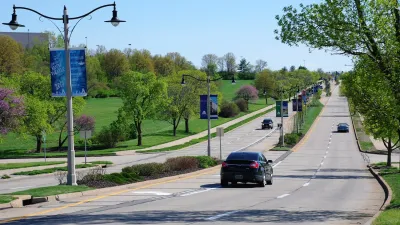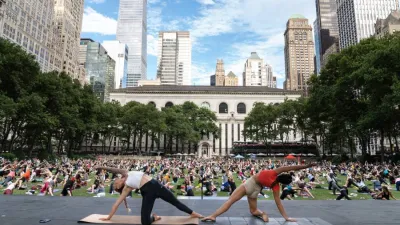As Britain confronts the silent epidemic of inactivity and obesity, Peter Walker examines how the invisible dangers of a sedentary lifestyle are compared to the more publicized risk of injury from activities designed to get people moving.
This week in Britain, the National Institute for Health and Clinical Excellence (Nice) released a stark report that finds, "almost two-thirds of men and nearly three-quarters of women in England are not sufficiently active to maintain their health, with the results little better for children," reports Walker. And as a solution to "a national epidemic of inactivity and obesity which now causes as much harm as smoking," the report's authors recommend that, "[w]alking and cycling should become the norm for short journeys rather than driving a car."
While the findings of the report are certainly dire, Walker seems equally astonished by one of the questions asked during the press conference in which the results and recommendations were announced. "One of the first was on cycle safety: had they taken into account the potential perils of riding a bike?" Some, it seems, are more fearful of the solution than the problem itself.
Walker quotes the answer to the question given by Dr Harry Rutter, lead author of the report and an adviser at the National Obesity Observatory: "All activities carry a risk...This focus on the dangers of cycling is something to do with the visibility of them, and the attention it's given. What we don't notice is that if you were to spend an hour a day riding a bike rather than being sedentary and driving a car there's a cost to that sedentary time. It's silent, it doesn't get noticed. What we're talking about here is shifting the balance from that invisible danger of sitting still towards the positive health benefits of cycling."
"People go on at exhaustive length about the perils of cycling because cycling remains niche," says Walker. "Sitting around on one's arse watching EastEnders and eating Pringles is, however, a national pursuit, and not enough people make the connection between that and an impact on health which is, the scientists told us, now on a par with that from smoking."
FULL STORY: Which really is more deadly: cycling or sitting down watching TV?

Planetizen Federal Action Tracker
A weekly monitor of how Trump’s orders and actions are impacting planners and planning in America.

USGS Water Science Centers Targeted for Closure
If their work is suspended, states could lose a valuable resource for monitoring, understanding, and managing water resources.

End Human Sacrifices to the Demanding Gods of Automobile Dependency and Sprawl
The U.S. has much higher traffic fatality rates than peer countries due to automobile dependency and sprawl. Better planning can reduce these human sacrifices.

Trump: Federal Government Won’t Pay for California HSR
The President has targeted federal funding for the California bullet train project since his first administration.

San Francisco Enhances Urban Planning Initiatives with Green Infrastructure
San Francisco incorporates green infrastructure in its city development initiatives, elevating the importance of sustainability in urban planning.

Chicago Approves Green Affordable Housing Plan
The Mayor’s plan calls for creating a nonprofit housing corporation tasked with building affordable housing that meets Green Building standards.
Urban Design for Planners 1: Software Tools
This six-course series explores essential urban design concepts using open source software and equips planners with the tools they need to participate fully in the urban design process.
Planning for Universal Design
Learn the tools for implementing Universal Design in planning regulations.
Tyler Technologies
New York City School Construction Authority
Village of Glen Ellyn
Transportation Research & Education Center (TREC) at Portland State University
Chaddick Institute at DePaul University
Institute for Housing and Urban Development Studies (IHS)
Regional Transportation Commission of Southern Nevada
Toledo-Lucas County Plan Commissions




























